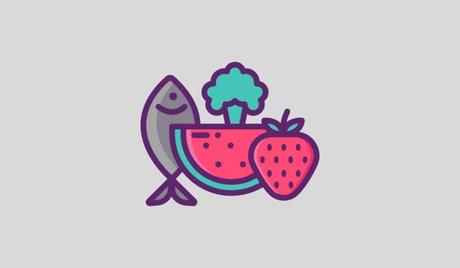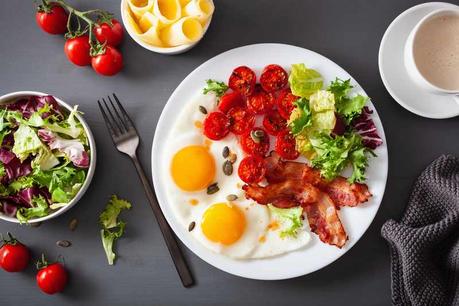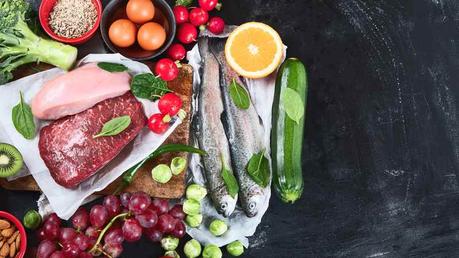Curious about the keto and paleo diets? Here is a detailed look at the differences between these two popular low-carb diets so that you can choose the best one for you and your health goals.

Keto and Paleo have become two of the most popular diets in recent years for those looking to make a change to their lifestyles.
Since the late 2000s, they’ve both exploded in popularity. And because you can generally eat a lot of really tasty, whole foods on both diets, it’s not hard to see why!
But choosing between the two may feel a little overwhelming for those new to the respective diets.
In this article, we’re going to discuss not only the differences but the pros and cons of each.
By the end, you will have a clear idea of which diet is best for you.
Let’s jump right in.
The Ketogenic Diet – Overview and Benefits
The Ketogenic Diet, or “Keto” as it’s often referred to, is one high in fats and proteins, and very low in carbohydrates.
With this significant restriction of carb intake, your body will go into ketosis: a metabolic state where your body uses stored fat as fuel rather than sugar/carbs.
There are frankly a ton of benefits from following keto, but here are some of the most notable:

Weight Loss
By metabolizing stored fat for energy, your bodyfat will almost certainly go down. You may not even feel much desire to eat heavily-processed foods.
Why?
Because foods that are high in fats and proteins will keep you feeling fuller, longer. Keto has been shown to reduce hunger levels1.
Reduced Blood Sugar/Insulin
Studies have shown that by reducing carb consumption, you’re also regulating blood sugar and insulin production.
Eating a carb-heavy meal or dessert can cause your blood sugar to skyrocket.
To try and balance things out, your body will bring it back down, which can cause it to crash.
This ends up with you having cravings for more carbs and sugars, causing the cycle to continue.
Keto avoids all of that, which means less cravings and a more consistent, healthy diet full of fewer processed foods.
Lower Cholesterol
Keto can help boost production of “good” or HDL cholesterol.
This also helps manage the amount of LDL cholesterol in your bloodstream.
Moreover, the Keto Diet can reduce blood triglycerides.
Triglycerides are essentially unused calories which are stored as fat.
High triglyceride levels can mean a higher risk of heart disease and greater fat storage, overall.
The Paleo Diet – Overview and Benefits
The Paleo Diet references what our ancestors ate during the Paleolithic era.
As you can imagine, this diet consists of a lot of things like meat, fish, fruits, veggies, nuts, and seeds.
However, Paleo does allow for carbs from whole foods like vegetables, fruits, and unrefined sweeteners.
This diet comes with its own set of benefits, as well.

Paleo is effective for weight loss
Various studies have shown that Paleo can help reduce waist circumference, and aids in overall weight loss.
In fact, they found that those who followed a Paleo Diet compared to those eating other diets reduced a larger percentage of their body mass index.
Lower Blood Pressure
Similar to with Keto, many who follow a Paleo Diet experience lower blood pressure, triglyceride levels, and improved HDL/LDL cholesterol ratios2.
More mindful eating
If you’re following a Paleo Diet, you’re more likely to eliminate processed and unhealthy foods from your diet.
You’ll catch yourself perusing the nutrition labels more, and select food without additives, preservatives, and harmful chemicals.
This in itself can result in weight loss, lowered inflammation, less brain-fogginess, improved energy levels, and so many other benefits.
Paleo and Keto: The Similarities
While both diets have their own idiosyncrasies in terms of what you can and cannot eat, they have a lot in common, including:
 Both encourage eating whole foods
Both encourage eating whole foods

Both diets promote cutting out or significantly reducing consumption of highly-processed foods.
If you’re following a Paleo Diet, this is likely even more intuitive. After all, no one in the Paleolithic era was eating hot dogs.
Probably

 Carb intake
Carb intake

Both involve a low intake of carbohydrates, and encourage cutting out all grains, starches, and legumes.
However, Paleo allows carbs from many fruits and vegetables that aren’t considered “Keto”.
The reason behind cutting out certain carbs is different for each diet.
Grains and legumes weren’t likely to be part of Paleolithic-era meals, which is why they’re not part of the Paleo Diet.
They can also kick you out of ketosis, so it’s not feasible to include on Keto, either.
 Emphasis on protein
Emphasis on protein

Meat lovers, rejoice!
Keto and Paleo both encourage getting your protein from meat and eggs.
Salmon, steaks, nuts, seeds, bugs – basically everything you’d find in the “wild” are allowed on Paleo.
These foods all fit into Keto, too.
 Reduction of added sugar
Reduction of added sugar

For both the keto and paleo diets, added sugars should be cut down, if not eliminated completely.
This kind of goes hand-in-hand with cutting out heavily-processed foods.
However, when it comes to Paleo, you have some more flexibility.
For example, you have the more “natural” sweeteners like maple syrup and honey that make sense to include in a Paleo diet.
After all, you could feasibly get both outdoors.
Keto is very restrictive from all sugar sources, regardless of how “pure” it may be, and because carbohydrates are very limited on keto, you need to be extra aware of both natural and added sugars.
See also: How Much Sugar Can You Have on Keto? (Plus the Best Keto-Friendly Sweeteners)
Paleo vs Keto: The Differences
 Paleo is more plant-based
Paleo is more plant-based

While Keto places a heavy focus on fat consumption, Paleo focuses more on consuming a lot of non-starchy vegetables.
Keto of course allows for low-carb vegetables such as cauliflower, broccoli, pickles/cucumbers, celery, tomatoes, spinach, and mushrooms.
But the vast majority of your macros are always going to be fats while on Keto.
For both diets, avoiding starchy veggies like beets, potatoes, and sweetcorn is important.
 Beverages
Beverages

While Keto allows for drinks like black coffee, sparkling water, low-carb juices, sports drinks, and certain energy drinks, Paleo encourages mainly water.
Related: Can You Drink Coffee on Keto? (Yes, Here is How)
Our paleolithic ancestors weren’t known for sitting around the camp fire and crushing Red Bulls, after all.
If you want to change things up a bit, you could opt for some tea or herbal infusions.
Perhaps even a bit of fruit juice, as well, ensuring it’s fresh-squeezed and not actually from concentrate.
For a bit more variety, you could take your fruits and veggies and make a green juice or smoothie out of them.
 Monitoring and planning
Monitoring and planning

With Keto, it is likely going to be necessary for you to monitor food weight and your intake – at least for the first few weeks.
Planning your meals on keto is crucial, whether you pick up a keto cookbook or use a keto meal planning app or program, in order to stay in the lane with your macros.
It’s all too easy to eat too much protein or carbs and get knocked out of ketosis, as a newbie.
With the Paleo Diet, there is less regimentation and monitoring required.
While you should be mindful of the type of carbs you consume, it’s more of a “lifestyle” rather than just a diet.
Want an individualized keto diet planning tool? Keto Custom Diet is my go-to meal planner. Tailored to your unique dietary needs, the program gives you a complete 14-day diet plan, including shopping lists and the ability to swap out foods without affecting macro counts. Read my full review of Keto Custom Diet here.
This makes it easy for many people to stick with in the long run.
It’s definitely possible to stay in ketosis for long periods of time, though a large percentage of those on Keto are only doing so to lose weight.
Once they lose that weight, they may go just low-carb or revert back to similar eating habits as before.
All in all, Paleo is a bit less labor-intensive. At least, at first. Keto gets much easier after a few weeks.
 Dairy Consumption
Dairy Consumption

While you may encounter fewer digestive issues with Paleo due to higher fiber intake (generally speaking), the diet is lacking quite a bit in calcium and vitamin D.
This is due to the diet cutting out dairy.
While you’re not likely to see negative side effects of this immediately, over time, it could weaken your bones and immune system.
 Carbohydrate intake (and carb hangover)
Carbohydrate intake (and carb hangover)

While both allow for a certain amount of carbs, on Paleo you aren’t really limited to the amount you can consume.
Rather, you’re limited to not eating starchy, high-carb vegetables.
Same with Keto.
However, due to the very low level of carbs on Keto, you are almost guaranteed to experience what is known as the keto flu, a set of symptoms that occur as your body transitions from being fueled by glycogen and carbs to being primarily fueled by fat.
This involves headaches, nausea/general gastrointestinal issues, cramping, fatigue, and irritability.
By keeping water and electrolyte consumption up, these should go away within a couple of weeks, maximum.
Using supplements like ketogenic diet pills are a way to speed up your body’s transition to ketosis, with studies showing that this form of supplementation can reduce the runway to ketosis by about half4.
Keto Charge – A Keto Pill That Actually Works (Full Review). Curious if Keto Charge can help you get into ketosis faster and achieve your weight loss goals? Read on for a full review, including key features, and see if it’s right for you.
With Paleo, you may feel somewhat fatigued over the first couple of weeks.
However, it shouldn’t be so intense that it makes it more difficult to stay on track during this time.
With Keto, it can be challenging to stay on track when experiencing the Keto Flu.
Just remember there are ways to reduce symptoms, and that it does get better!
 Weight Loss
Weight Loss

We mentioned earlier that people on both diets tend to lose weight, when following them correctly.
However, people who prefer Keto tend to place weight loss as their main priority.
On Paleo, you can realistically binge on nuts and fruits and you can eat more than your required calorie allotment.
This can cause you to gain weight.
Keto isn’t some magical toner-upper, but people do tend to lose more weight by following it3.
Why?
Because of reduced cravings.
Keto helps keep your blood sugar and insulin levels in check, keeping your energy levels and appetite more consistent.
Not only that, but fat is more satiating and keeps you feeling full for longer periods of time.
You’ll be more satisfied with your meals, and may even get full, quicker.
The Bottom Line
Keto and Paleo diets are both great options if you’re looking to make healthy, positive changes to your life.
While there are many similarities, there are many notable differences to take into consideration.
At the end of the day, one will likely suit you much better than the other.
And it’s perhaps most important to be realistic about which of the two you are more likely to stick with over time.
It all depends on your goals and lifestyle, so make sure you know what you want to accomplish and what you are willing to do to get there.
More Keto Guides and Resources
9 Keto Diet Tips and Tricks for Beginners. Get started with the keto diet the right way with these nine proven tips and tricks for beginners.
What Should I Eat on the First Day of Keto? Thinking about trying out the keto diet but don’t know how to get started? Here’s your detailed guide on what to eat on the first day of keto.
7 Best Supplements to Get into Ketosis Faster. The keto diet is a proven way to lose weight and reduce belly fat. But it’s rarely easy. Here are some keto supplements to accelerate your progress with the ketogenic diet.
